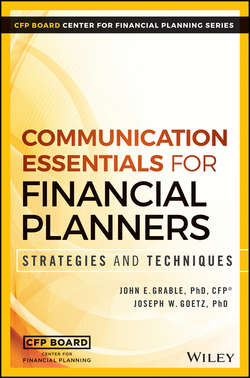Читать книгу Communication Essentials for Financial Planners - Grable John E. - Страница 6
На сайте Литреса книга снята с продажи.
Preface
COMMUNICATION: WHAT IS IT?
ОглавлениеBefore moving forward, it is worth pausing and clarifying exactly what this book is all about. The word communication is very broad and used in multiple ways in the financial planning profession. Communication can be broken down into four domains:
■ Communication methods
■ Communication tasks
■ Communication topics
■ Communication skills
Much of the financial planning literature relative to communication really focuses on methods of communication, such as using a phone, email, blogs, face-to-face meetings, newsletters, mailers, social media, and group functions. All of those elements are important to client engagement, but there is much more to becoming a truly proficient communicator. Communication tasks encompass a variety of procedures and practice standards (for example, explaining how advice matches a client’s goals and objectives). It is important to note that communication topics can vary from client to client, including conversations about a client’s values, for example, to discussions regarding specific products and procedures. While these three elements of communication are very important, this book is focused more intently on the purpose of communication and communication and counseling skills (e.g., verbal, nonverbal, and spatial skills). Table P.2 illustrates the difference between communication tasks and communication and counseling skills. As noted earlier, the focus of this book is squarely on the skills needed to be an effective financial planner.
TABLE P.2 Communication Tasks and Skills Compared
Source: Adapted from Sharpe et al. (2007).
Even though this book only tangentially touches on methods, tasks, and topics of communication, the research surrounding the usefulness of these communication elements is astounding and worth reviewing. When asked, nearly 50 percent of practicing financial planners have historically indicated that they spend between 9 and 14 hours per week communicating with clients.7 Financial planners who claim the greatest success in growing their practice, however, report communicating directly with clients at least 30 to 34 hours per week. The most popular (not necessarily the best) methods of communication include the telephone, email, face-to-face meetings, and newsletters. The reasons for communicating are diverse, including reviewing a client’s goals, evaluating portfolio performance, providing advice, discussing life events, staying in touch, providing market commentary, and educating clients. Some financial planners also use methods of communication to ask for referrals.
The number of hours successful financial planners spend communicating with clients sometimes surprises aspiring financial planners. It is a common belief that financial planners spend the majority of their time devoted to evaluating quantitative data. While this may be true for some financial planners – particularly those who work in larger firms where task specialties are the norm – the most successful financial planners tend to devote less than 50 percent of their working day to quantitative issues. More time is spent on coaching and counseling activities.8 As an example, the following communication tasks and topics are frequently reported as being important when building long-lasting and committed client–financial planner relationships9:
■ Counseling a client who is emotionally distraught
■ Mediating between husband and wife
■ Mediating between client and children
■ Prompting a client to seek therapy
■ Encouraging a client’s family member to seek therapy
■ Discussing prayer and God with some clients
■ Acting as a keeper of client secrets
■ Lobbying a client to engage in philanthropic activities
It should be obvious that communication skills are at the root of all impactful financial planning services. Based on the existing literature, it is hardly a stretch to conclude that communication and counseling skills are among the most important characteristics separating successful financial planners from others.
7
C. Nelson, “Communication Styles and Business Growth,” Journal of Financial Planning 23, no. 9 (2010): 8–11.
8
D. Dubofsky and L. Sussman, “The Bonding Continuum in Financial Client-Financial Planner Relationships,” Journal of Financial Planning 23, no. 10 (2010): 66–78.
9
Id., 76.
